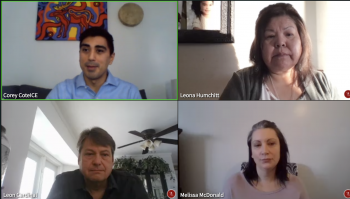Image Caption
Summary
Local Journalism Initiative Reporter
Windspeaker.com
The COVID-19 pandemic has brought countless projects around the world to a standstill.
Many others, like the clean energy plan for Heiltsuk Nation in Bella Bella, B.C., have been forced to pivot somewhat but are still moving forward.
Leona Humchitt, the climate action co-ordinator for Heiltsuk Nation, was among three presenters on Jan. 21 at the Indigenous Clean Energy E-Gathering discussing current programs in their communities.
Besides Humchitt, the presentation featured two other project leads from Indigenous communities involved with the Indigenous Clean Energy’s Bringing It Home Initiative. They were Melissa McDonald from the Red Rock Indian Band in northwestern Ontario and Leon Cardinal from the Fishing Lake Métis Settlement in Alberta.
Corey Cote, Indigenous Clean Energy’s program co-ordinator, moderated the presentation.
This Bringing It Home Initiative, which currently involves six communities across Canada, is focused on scaling up energy efficiency in Indigenous communities.
Humchitt said the pandemic has forced those in her community to meet differently, but work on its clean energy plan has continued.
“With COVID we had to pivot from where we would gather in person as a community to online, and that’s been challenging,” Humchitt said. “But we’re overcoming those barriers by really working together as a team and wanting to address the needs of our people by asking them what’s important to them in terms of clean and renewable energy.”
Heiltsuk Nation’s clean energy plan kicked off back in 2017 with assessments.
“In 2018 we commenced with a pilot project in 20 homes,” Humchitt said. “A second round of 20 heat pumps were later installed.”
Humchitt said a positive thing about pilot projects is that they can be reviewed and changes made if those ventures continue.
“Most homes in Bella Bella are two storeys so the next installs we pivoted to essential heating using existing furnace ducts for an even distribution of heat and air conditioning,” she said. “By March 31 we will have retrofitted 129 of our 420 residential units.”
Humchitt said educating Heiltsuk Nation residents is a vital component of the community’s clean energy plan.
“We’ve shared with them that it’s important to know that it costs less to save a kilowatt than to generate one.”
Humchitt said that it is important residents in the community are aware of benefits they will incur.
“Heat and electricity bills on average per annum was $3,600 per home,” she said. “Fuel switching to heat pump eliminates five tonnes of greenhouse gas emissions annually. With the 129 homes we will have completed by March, 645 tonnes of greenhouse gas emissions will have been eliminated. And we’ll also have reduced our fuel consumption by 2,000 litres of diesel per home.”
Humchitt said officials in her First Nation are not content yet with the proposed changes.
“Our goal is to continue to find as much funding to retrofit all of our homes in the community,” she said.
McDonald said Red Rock Indian Band, located about 120 kilometres northeast of Thunder Bay, also has some lofty goals and is eager to deal with its current housing situation.
The First Nation has 116 houses and 323 permanent residents.
“The initiative will solve the issues that current home occupants are having from some sub-standard construction practices, such as air leaking through doors and windows, mold issues or insufficient heat,” McDonald said.
She’s hoping the situation improves considerably and the sooner the better.
“Red Rock’s goal is to create construction policies that go beyond minimum building code and create net zero home plans for future construction,” McDonald said. “This will help stop the cycle of sub-standard construction. We will also have energy and structural audits on all the existing reserve homes and do any retrofits to get them to net zero ready.”
McDonald said community members will be employed to do the work.
“Throughout the project we will utilize local community members to do the retrofits and we will provide training for the retrofit crew, energy auditors and training for the home occupants for home maintenance plans,” she said.
Red Rock officials are not only planning to upgrade current homes and build better ones but they will also construct another vital facility.
“For Red Rock, our project will be constructing a highly energy efficient safehouse facility for Indigenous women and children that will be on the reserve,” she said.
Cardinal said his community had some big clean energy plans prior to the pandemic. Since then community engagements have been limited to five-person sessions to follow safety protocols.
Cardinal said the goal is still to strive to implement clean energy plans in his community.
“I think the biggest impact is breaking cycles,” he said. “We don’t do the same old, same old. We look and find solutions to problems. We don’t try to build off of something that isn’t working. We’re going in a totally new direction.”
Cardinal said creating a community vision is extremely important.
“If everybody gets to be on the same page, it makes it that much easier to push things forward,” he said.
Local Journalism Initiative Reporters are supported by a financial contribution made by the Government of Canada.

